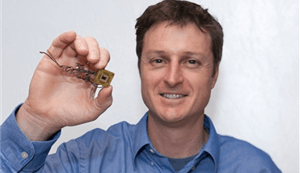Nano Rectannas Grab More Energy From Sunlight
on

Even the best silicon panels collect only about 20% of available solar radiation and they require additional devices to convert the energy to usable electricity. A new technique using nano-sized antenna arrays could theoretically harvest more than 70% of the energy in sunlight, but the technology required to build and test them has been lacking. These nano-antennas, called "rectennas" because they can both absorb solar radiation and rectify the radiation waveform to generate direct current, must operate at the frequency of visible light and be fabricated with the core set of electrodes just 1 or 2 nm apart.
A novel fabrication process called selective area atomic layer deposition (ALD) developed at the University of Connecticut offers a potential solution to this challenge. In a rectenna device, one of the two interior electrodes must have a sharp tip, similar to the point of a triangle. Using ALD the tip of the rectenna can be coated with layers of individual copper atoms until a gap of about 1.5 nm is achieved. The best that could be done with previous lithographic fabrication techniques was a separation about ten times the required value.
The gap size is critical because it forms an ultra-fast tunnel junction between the rectenna’s two electrodes, enabling maximum current transfer. The nano-sized gap gives energized electrons on the rectenna just enough time to tunnel to the opposite electrode before the potential reverses. The triangular tip of the rectenna makes it hard for the electrons to reverse direction, thus capturing the energy and rectifying it to direct current.


Discussion (0 comments)